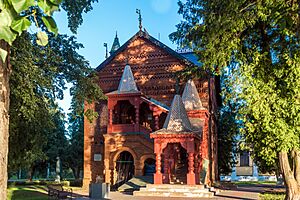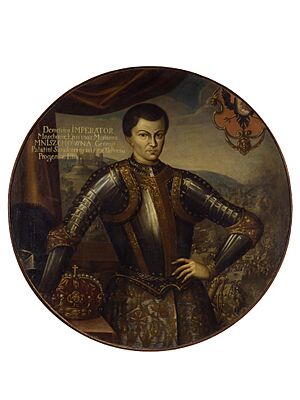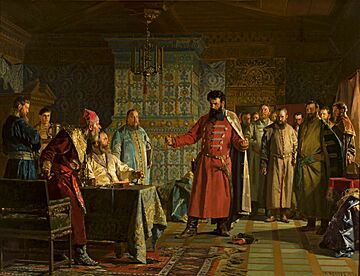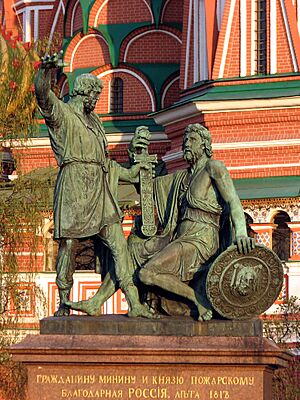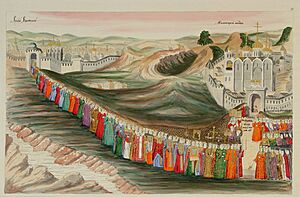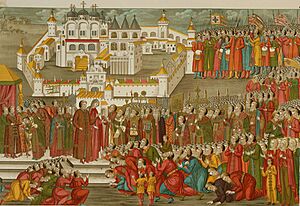Time of Troubles facts for kids
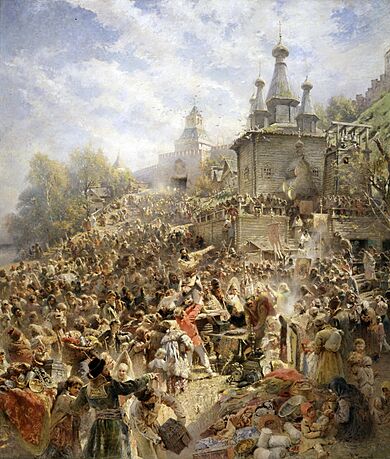
The Time of Troubles (Russian: Смутное время, romanized: Smutnoye vremya), also known as Smuta (Russian: Смута, lit. 'troubles'), was a very difficult period in Russia. It started in 1598 when Feodor I died. He was the last ruler from the Rurik family. The troubles ended in 1613 when Michael I from the House of Romanov became tsar.
This time was full of big problems for society and a lot of lawlessness. After Feodor I, a weak ruler, died without any children to take his place, the Rurik family's rule ended. This led to a fierce fight over who would be the next ruler. Many people claimed to be the true tsar, including several false Dmitrys (imposters). Russia also suffered a terrible famine from 1601 to 1603. This famine killed almost a third of the population. Russia was also taken over by the Polish–Lithuanian Commonwealth during the Polish–Russian War. During this war, Russia lost the city of Smolensk.
The Time of Troubles finished when Michael Romanov was chosen as tsar by a special meeting called the Zemsky Sobor in 1613. This started the Romanov family's rule, which lasted until the February Revolution in 1917.
Contents
Why the Troubles Started

Tsar Feodor I was the second grown-up son of Ivan the Terrible, Russia's first tsar. Feodor's older brother, Tsarevich Ivan Ivanovich, was supposed to be the next ruler. Feodor was not expected to become tsar. However, Tsarevich Ivan was accidentally killed by his father in 1581. This made Feodor the new heir.
Before Ivan the Terrible died in 1584, he knew Feodor might not be able to rule alone. So, he set up a group of advisors to help his son. This group included two important nobles, Nikita Romanovich Zakharyin-Yuriev and Prince Ivan F. Mstislavsky. It also included Prince Ivan Petrovich Shuisky and Feodor's brother-in-law, Boris Godunov. Boris Godunov quickly became the most powerful person among these advisors.
Over time, Boris Godunov became the only main advisor to Tsar Feodor. He was the most powerful man in Russia.
In the mid-1500s, Russia faced many problems. There were famines, diseases, and internal fights. On top of this, the Crimean Khanate often raided Russia's lands. In 1571, their army even burned Moscow.
After Tsar Ivan's death in 1584, Feodor was crowned tsar. Feodor was a very religious person and did not care much for politics. He ruled through Boris Godunov, who was his closest advisor. Feodor had one daughter, Feodosia, but she died when she was only two years old.
In 1591, there were reports that Ivan the Terrible's youngest son, Dmitry, had died. Then, in January 1598, Tsar Feodor died without any children to take his place. This meant the Rurik family, who had ruled Moscow for a long time, had no more heirs. Feodor's wife, Irina, gave up the throne and went to live in a convent.
The nobles then held a meeting, the Zemsky Sobor, to choose a new tsar. Boris Godunov was chosen and crowned in September 1598. He was a very strong ruler and helped Russia grow. However, he also made life harder for many people by increasing taxes and making some laws stricter.
Russia then faced a terrible famine from 1601 to 1603. Summers were so cold that temperatures often dropped below freezing at night. This led to widespread hunger and disease, killing a huge number of people. There were also riots and rebellions because of the hunger.
False Dmitry I: A Pretender to the Throne
After Feodor's death, many people started to believe rumors. They said that his younger brother, Dmitry, was still alive and hiding. This was despite official reports that Dmitry had died young. Russia's unstable situation was used by several people who claimed to be Dmitry. These people are known as False Dmitrys.
The first of these, False Dmitry I, appeared in the Polish–Lithuanian Commonwealth in 1603. He claimed to be the true heir to the Russian throne. Some Russian nobles helped him, and he gained support from Cossacks. He also got help from Polish leaders and Jesuits, who hoped he would convert Russia to Catholicism.
In October 1604, False Dmitry I and his army crossed into Russia. His arrival started the first part of Russia's civil war. Many people in the southern parts of Russia joined his rebellion.
After Boris Godunov died in 1605, False Dmitry I entered Moscow triumphantly. He was crowned tsar on July 21. He made sure people believed his story by visiting the tomb of Ivan the Terrible. Ivan's widow, Maria Nagaya, even accepted Dmitry as her son. False Dmitry I married Marina Mniszech, a Polish princess, in 1606. He relied on Polish nobles and their private armies, which made many Russians dislike him.
Vasili IV Shuisky: The Boyar Tsar
Prince Vasilii Shuiskii was a very important noble whose family had a long history in Russia. He was a strong opponent of False Dmitry I. Soon after Dmitry became tsar, Vasilii and his brothers spread rumors that the tsar was actually a runaway monk named Grishka Otrepyev.
False Dmitry I quickly became unpopular. Many Russians saw him as a puppet of the Poles. On May 17, 1606, just ten days after his wedding, Dmitry was killed by angry mobs in Moscow. Many of his Polish advisors were also killed or put in prison.
Vasilii Shuiskii and his supporters had secretly planned to kill Tsar Dmitry. They included other nobles, church leaders, and merchants. On the morning of May 17, 1606, they led an attack on the Kremlin. They spread the word that the Poles were trying to kill the tsar. A terrible massacre followed, with hundreds of Poles and Russians killed. The tsar was killed while trying to escape. Vasilii Shuiskii then tried to make the tsar look bad, claiming he was a sorcerer. Dmitry's body was left in Red Square for three days and then burned.
On May 19, 1606, Vasilii Shuiskii was declared tsar. However, he was not very popular. Many people saw him as a liar and someone who took power without proper approval. This made his rule unstable from the start. He was called the "boyar-tsar" because he was chosen by a small group of nobles.
Soon, new rebellions began. A man claiming to be "Tsarevich Petr," the mythical son of Tsar Feodor Ivanovich, appeared. He was actually a cobbler's son. In January 1607, this "Tsarevich Petr" led an army of 30,000 men. Tsar Vasilii's army besieged them in Tula.
In July 1607, another imposter, False Dmitry II, came forward. He was joined by Polish lords and mercenaries. His army grew and in April 1608, he attacked Tsar Vasilii's forces. He then set up his court in Tushino and began to besiege Moscow for the next 18 months. Many nobles, including members of the Romanov family, joined him.

During this time, Russia was flooded with many other people claiming to be the tsar. However, False Dmitry II did not allow any rivals.
In November 1608, people started to fight against False Dmitry II. Tsar Vasilii also faced coup attempts. In the summer of 1609, the Crimean Tatars invaded Russia again, taking people as slaves.
In February 1609, Prince Skopin-Shuisky signed a treaty with Charles IX of Sweden. Sweden agreed to provide mercenaries in exchange for land. In September 1609, King Sigismund III Vasa of Poland invaded Russia and began the siege of Smolensk. In late December 1609, False Dmitry II fled to Kaluga, causing his camp to break apart.
On February 4, 1610, Russian nobles from the False Dmitry II's court signed a treaty with Sigismund III. They hoped to end the civil war by inviting Sigismund's son, Wladyslaw, to become tsar.
Tsar Vasilii made his brother Dmitry Shuisky his main commander. In June, Dmitry Shuisky had an army of 30,000 men, helped by Swedish mercenaries. However, during the Battle of Klushino, the Russian army was defeated by the Poles. The Poles then advanced towards Moscow. At the same time, False Dmitry II's army also moved closer to Moscow.
Polish and Swedish Involvement
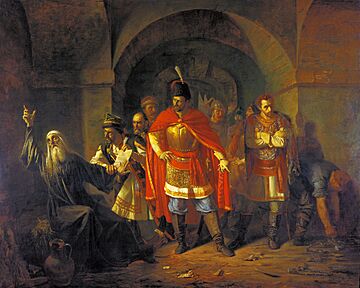
Tsar Vasilii no longer had an army. Many nobles plotted to overthrow him. On July 17, they arrested Shuiskii, forced him to become a monk, and imprisoned him. A group of Seven Boyars then ruled Russia. With the Polish army and False Dmitry II's army threatening Moscow, the Seven Boyars agreed to invite Wladyslaw to rule. On August 17, about ten thousand Russians swore loyalty to Tsar Wladyslaw.
However, King Sigismund's real plan was to conquer and rule Russia himself. He arrested potential candidates for the throne and continued the siege of Smolensk. He also allowed Polish raids on Russian towns and placed a Polish army in the Kremlin. On December 11, 1610, False Dmitry II was killed. His widow, Marina, gave birth to his son. Muscovites began to hate the foreign rulers and the Russians who helped them.
Anti-Catholic and anti-Polish feelings grew in Russia. Sweden also started the Ingrian War. By this time, Russia was in chaos. The throne was empty, nobles argued, the Orthodox Patriarch Hermogenes was imprisoned, Catholic Poles occupied the Kremlin, Smolensk was still under siege, and Protestant Swedes occupied Novgorod. Many people died in battles and riots. Bands of robbers roamed the land, and Tatar raids made southern Russia empty.
People's anger grew in early 1611. Many wanted to end the Polish occupation. Polish and German soldiers put down riots in Moscow from March 19 to 21, 1611. They killed 7,000 people and set the city on fire. The Polish commander ordered the outer city burned to stop the uprising. The Polish occupation was then limited to the Kremlin and Kitaigorod, which the Poles looted.
In the spring of 1611, a national militia was formed. Its leaders included Prokofi Liapunov and Cossack leaders Dmitrii Trubetskoi and Ivan Zarutskii. However, Liapunov was killed in a fight with the Cossacks in July 1611. Zarutskii became the militia leader.
False Dmitry III appeared in Novgorod in March 1611. Many Cossacks supported him. But Zarutskii saw him as a threat and had him captured and executed in May 1612.
In the fall of 1611, Kuzma Minin, a butcher from Nizhny Novgorod, started collecting money. He used these funds to create a second militia (Russian: Второе народное ополчение). Minin asked Prince Dmitry Pozharsky to lead this new army. Yaroslavl became the headquarters for this growing militia and the new temporary government. In June 1612, Pozharskii made a truce with Sweden. This allowed his army to march towards Moscow, arriving there on July 28, 1612.
The Battle for Moscow
In January 1612, some of the Polish army left Russia because they were not paid. The Second Volunteer Army joined other Russian forces fighting the Poles in Moscow. They besieged the Polish soldiers in the Kremlin. This new army was well-armed and organized. They took Yaroslavl in March 1612 and set up a temporary Russian government.
Minin and Pozharsky entered Moscow in August 1612. They learned that a 9,000-strong Polish army was coming to help the besieged Poles. On September 1, the Battle of Moscow began. The Polish forces reached the city, using cavalry attacks and new tactics. After some early successes, the Polish forces were pushed back by Russian Cossack reinforcements. On September 3, the Poles attacked again, reaching the Kremlin walls. However, Moscow's narrow streets stopped their movement, and they had to retreat after a Russian counter-attack. On September 22, 1612, the Poles and Lithuanians captured and burned Vologda, killing and capturing many people. Many other cities were also destroyed.
On October 26, the Polish soldiers in the Kremlin surrendered. The next day, October 27, the national militia forces entered the capital.
Michael Romanov and What Happened Next
The Zemsky Sobor chose Michael Romanov, who was 16 years old, to be the new tsar of Russia on February 21, 1613. He was crowned on July 21. Michael Romanov was related to the old Rurik family through marriage. It is said that a brave peasant named Ivan Susanin saved him from his enemies. After Michael became tsar, he ordered False Dmitry II's three-year-old son to be killed. Marina Mniszech, False Dmitry II's widow, was reportedly murdered in prison.
The Ingrian War with Sweden lasted until 1617, and the war with Poland continued until 1619. Russia gained peace but had to give up some land to Sweden and Poland. However, most of this land was taken back later. The Time of Troubles brought all parts of Russian society together around the Romanov tsars. This helped set the stage for later changes by Peter the Great.
The conflict caused many deaths, with estimates ranging from 1 to 1.2 million people. Some areas of Russia lost more than half their population. Because there were fewer people, peasants' wages improved, and the process of making people into serfs slowed down.
Stories and Art from the Time of Troubles

Unity Day is celebrated every year on November 4 in Russia. It remembers when the Polish soldiers in the Kremlin surrendered. This holiday was brought back by President Vladimir Putin in 2005.
The Time of Troubles has inspired many artists and writers. The most popular stories are about:
- The liberation of Moscow by Pozharsky and Minin.
- The struggle between Boris Godunov and False Dmitry I.
- Ivan Susanin, a peasant who supposedly gave his life to lead the Poles away from Mikhail Romanov.
Some famous works include:
- A Life for the Tsar (an opera by Mikhail Glinka)
- Boris Godunov (a play by Alexander Pushkin)
- Boris Godunov (an opera by Modest Mussorgsky based on Pushkin's play)
- The Monument to Minin and Pozharsky in Red Square.
- Minin and Pozharsky (a film from 1939).
- 1612 (a 2007 epic film).
Many Russian and Polish artists have painted scenes from this period. Historian Chester Dunning wrote that modern Russia truly began in 1613 with the start of the Romanov dynasty.
See also
- Ivan Bolotnikov
- Crimean–Nogai slave raids in Eastern Europe


